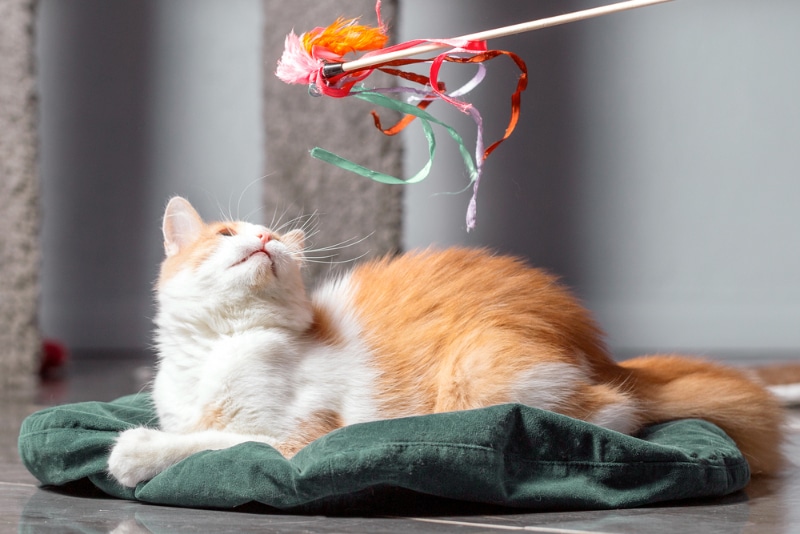A cat wand is one of the many types of toys that keep our beloved felines happy, active, and entertained. While there are plenty of different wand toys commercially available, DIY ones are also sure to strike your cat’s fancy. So, if you are a cat lover who enjoys working with your hands, we have amazing toy wand ideas for you to check out.
Top 10 DIY Cat Wand Plans
1. DIY Cat Ribbon Wand Toy
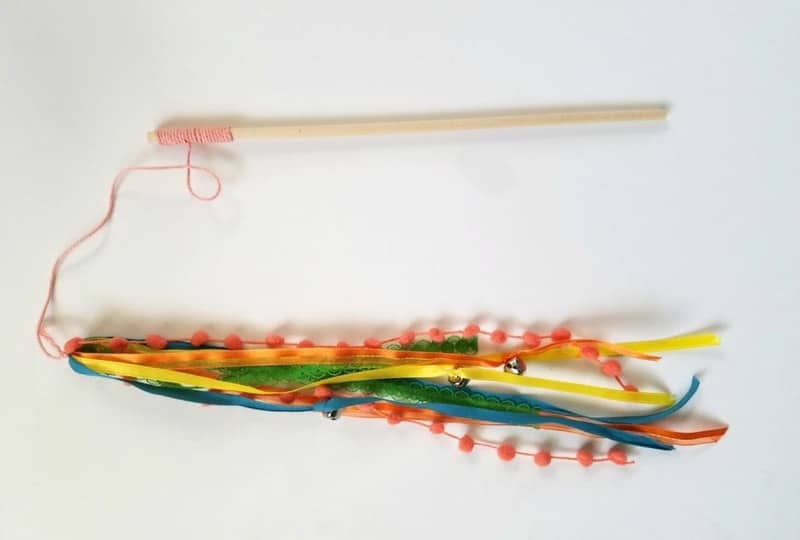
| Materials: |
Wooden dowel, baker’s twine, craft glue, 15–24-inch ribbon (five different colors/types)
|
| Tools: | Scissors |
| Difficulty Level: | Easy |
This creative, colorful DIY wand toy is not only easy to make but can also be customized to fit your personal preference. All you need is a wooden dowel, some baker’s twine, some craft glue, scissors, and at least five different pieces of ribbon.
2. Modern DIY Cat Wand Toy
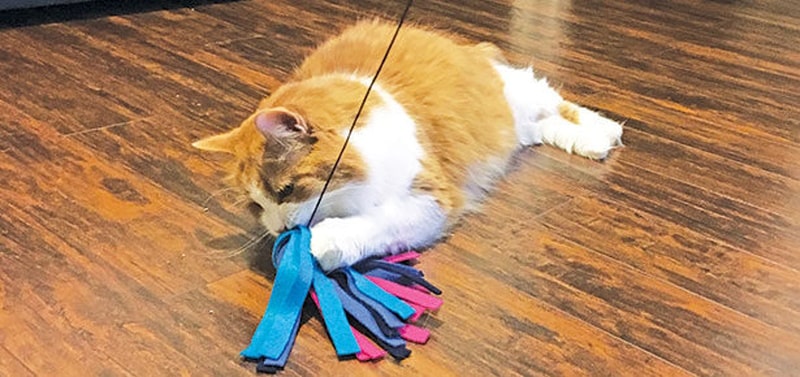
| Materials: | Wooden dowel, felt, leather cording, glue |
| Tools: | Scissors, glue gun |
| Difficulty Level: | Easy |
This DIY wand gives a modern spin to your cat’s new toy. You should have no trouble throwing this together as long as you can tie a double-knot. It’s recommended that you have a good glue gun to glue the leather cording to the wooden dowel. Other than that, you just need some felt, scissors, and just a little bit of patience for the necessary threading.
3. DIY Cat Toy Ribbon Wand
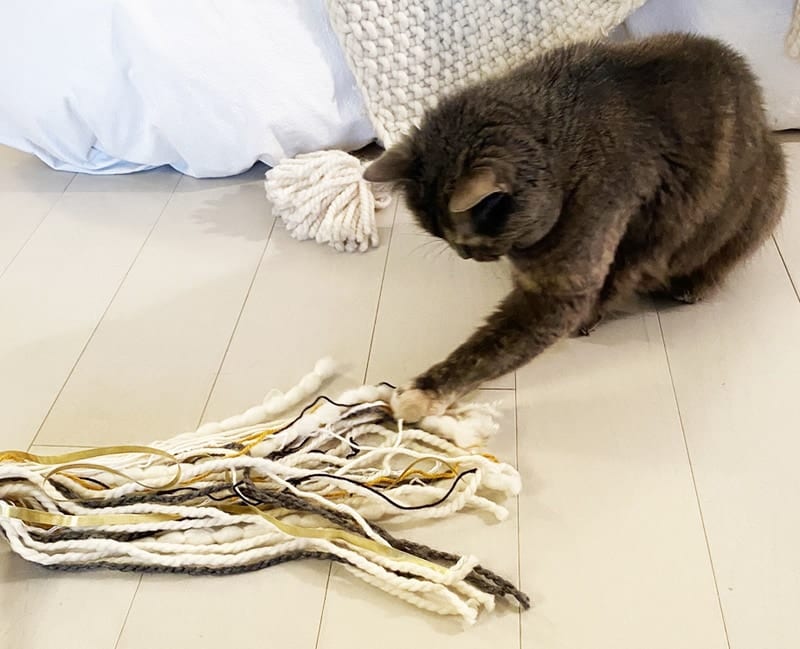
| Materials: |
Wooden dowel or steel rod, yarn, ribbon, trim or crochet thread, glue
|
| Tools: | Scissors, glue gun, toothpicks |
| Difficulty Level: | Moderate |
This cat wand has a way of being entertaining yet elegant with its golden color scheme. Now, you don’t have to use gold if you don’t like it; you can just take the idea and form it to fit your taste. For this project, you can either use a wooden dowel or a steel rod, some yarn, ribbon, trim, or crochet thread.
The only tools you need are scissors, a glue gun, and some toothpicks to help you get the job done. Read the instructions carefully because they do differ slightly depending on whether you use the wooden dowel or the steel rod.
4. Simple DIY Cat Wand
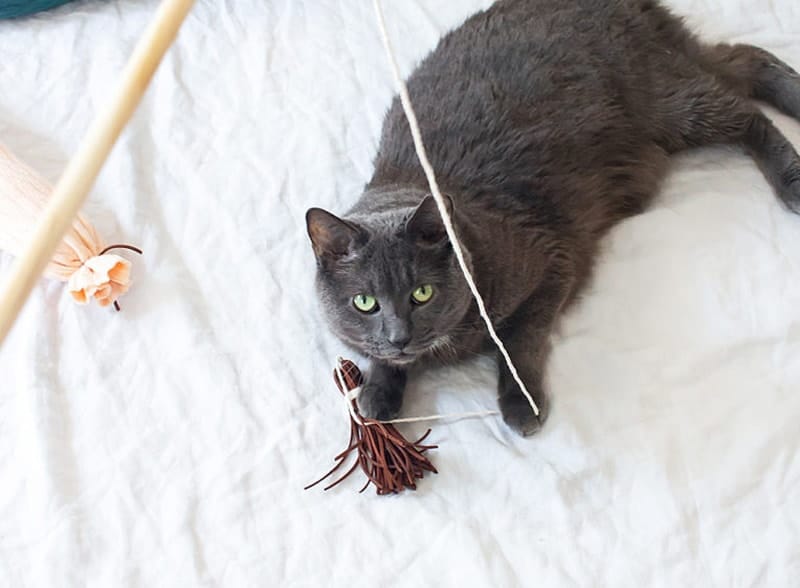
| Materials: |
Wooden dowel, leather lace, real or faux leather fabric, cotton twine, glue
|
| Tools: | Scissors |
| Difficulty Level: | Easy |
If you’re looking for a simple yet attractive cat wand that is cheap and easy to make, look no further. This DIY plan requires very little; aside from materials, you just need scissors and good-quality glue. We recommend opting for E600 or some other clear, strong glue.
You will use either leather or faux leather fabric with some leather lace to create your tassel and cotton twine to hang it from. Your cat is sure to enjoy this, and you will likely be impressed at how quick and easy the process is.
5. Fishing Pole Cat Toy DIY
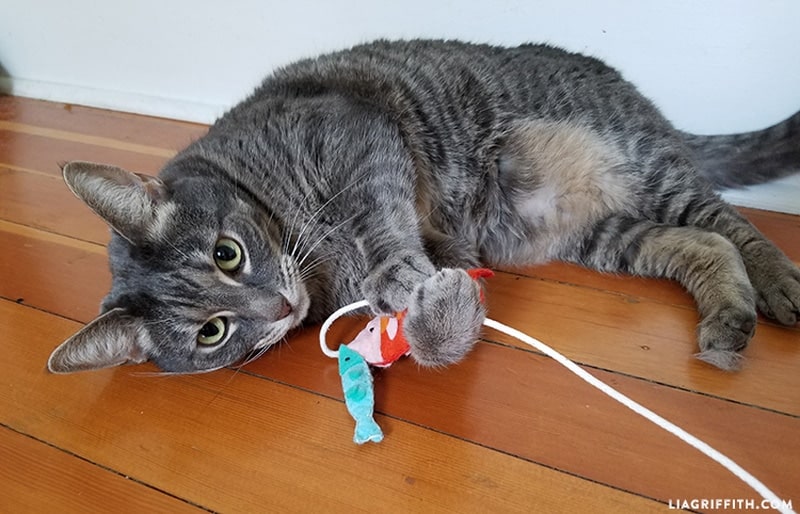
| Materials: |
16-inch wooden dowel, wool/wool blend felt, matching embroidery floss, acrylic craft paint, cotton clothesline/thin rope, catnip
|
| Tools: | Craft scissors, hot glue gun, embroidery needle, paintbrush |
| Difficulty Level: | Moderate |
We absolutely love this fishing pole wand toy, and it allows DIYers to put their craft skills to the test. This plan requires a bit more detail than some of the others, but it is worth it in the long run. While it may require a bit more materials, it’s still an inexpensive project overall.
One thing your cat is sure to love is the added catnip that will entice their play drive even further. If you gather up all your necessities and follow the directions carefully, you will have the perfect fishing pole that comes complete with a couple of fish on the line.
6. DIY Feather Wand Toy
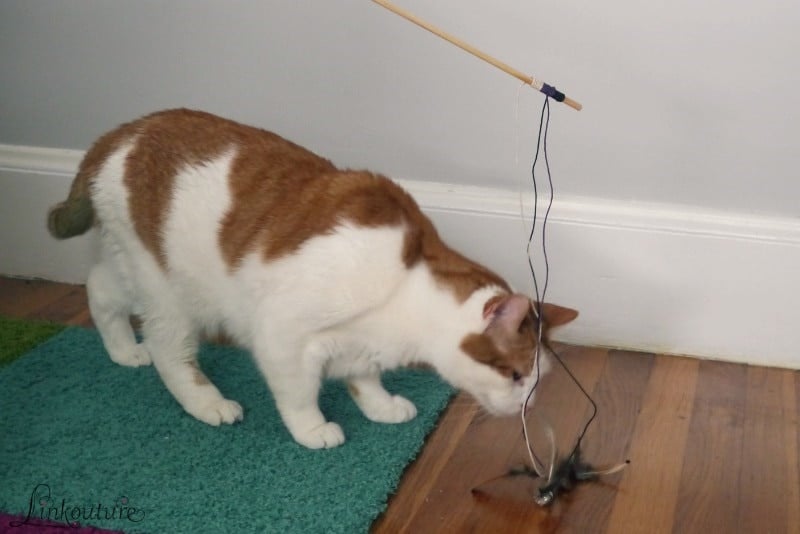
| Materials: | Wooden dowel, string, feathers, bells |
| Tools: | Scissors |
| Difficulty Level: | Easy |
Let’s face it: Most cats love feathers, which is why they are such popular additions to a lot of commercial cat toys. This super-easy DIY feather wand toy is sure to put your cat in play mode at first sight.
Other than your wooden dowel, you just need some feathers, bells, string, and scissors to do the cutting. You don’t need any glue for this project because you simply tie the feathers and bells with the string. According to the instructions, this should take no more than 5 minutes to throw together.
7. DIY Cat Charmer Ribbon Wand Toy

| Materials: | Wooden dowel, screw eye hook, washi tape, shoelaces |
| Tools: | Scissors |
| Difficulty Level: | Easy |
You’ve heard of snake charmers, but have you wondered what it takes to become a cat charmer? Well, it doesn’t involve any musical instruments or venomous snakes; all it takes is this wand toy and you will have them wooed in no time.
For this project, you just need a wooden dowel, some shoelaces, washi tape, and a screw eye hook to attach everything. You can keep it simple or get creative and stylish with the shoelaces. This may help alleviate your cat pawing after you when you have your shoes untied too.
8. DIY Feather Boa Cat Toy
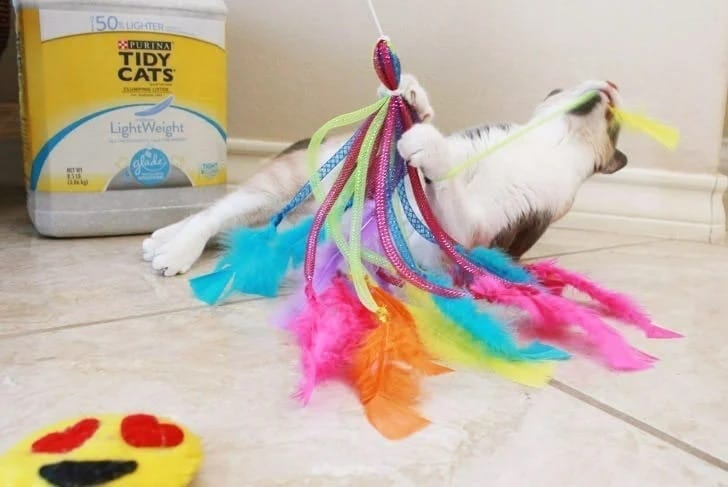
| Materials: | Wooden dowel, loose craft feathers, string, ribbon, feather boa |
| Tools: | Hot glue gun, scissors |
| Difficulty Level: | Easy |
This DIY wand involves a feather boa, some colorful string, ribbon, loose craft feathers, and a wooden dowel to hook it to. You will need a hot glue gun for the project, but it can be thrown together rather easily and is sure to capture your cat’s attention.
9. DIY Taped Cat Wand Toy
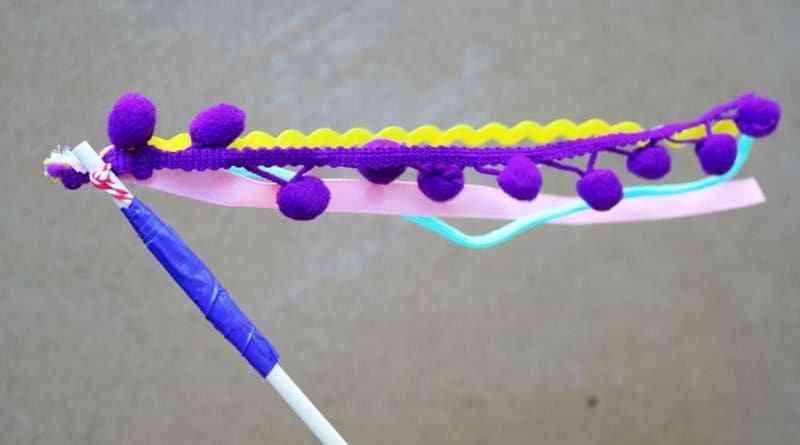
| Materials: |
Wooden dowel, string, ribbon, bakers twine, duct tape, feathers, bells
|
| Tools: | Scissors |
| Difficulty Level: | Easy |
If you need something quick and easy to throw together without any knots or threading materials through the dowel, this DIY wand idea would be great for you. You can spoil your cat quickly by just taping the material to the dowel using good-quality duct tape.
Thankfully, you can still get colorfully creative with duct tape, considering all the color and design options available nowadays. This is a good way to keep a simple spin on the project without looking like you carelessly threw it together.
10. DIY Cat Wand With PomPoms and Catnip

| Materials: |
Wooden dowel, felt, ribbon, needle, feathers, nylon string, cotton balls, pompoms, catnip, glue
|
| Tools: | Scissors, glue gun |
| Difficulty Level: | Difficult |
This crafty DIY cat wand involves some more precision and skill than some of the others, but as you can see, it will make a great source of entertainment for the felines. You will use a variety of felt, ribbon, and string along with some cotton balls, pompoms, and catnip to top it off.
You will want a good quality glue gun for this project since you will be creating your own little toys to dangle off the wand. You will also need a good pair of craft scissors to help you out.
Benefits of Cat Wand Toys
Cat toys should be part of every cat owner’s home. It’s easy to see why cats take to wand toys so well; not only are they a fun and engaging way to keep our four-legged family members entertained, but they also have many other benefits. Whether you want to create a DIY cat wand or buy one premade, here is a list of the benefits playing with wand toys can have.
Promotes Activity and Exercise
Cats may spend at least half of their day sleeping, but they also require some form of exercise to keep them healthy and happy. Wand toys naturally stimulate their drive to hunt, making them toys that are quite hard to resist.
It helps that their human is behind the wheel in this sense because your movement helps entice them even further. Even the laziest of cats can be entertained by a wand toy. If nothing else, it gives them an activity to participate in and some much-needed movement.
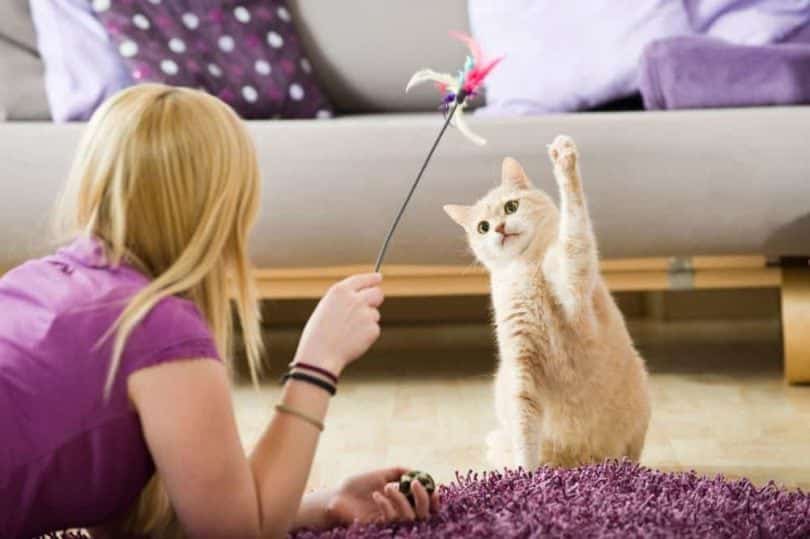
Provides Mental Stimulation
Cats can be quite adventurous little animals that are full of curiosity. While the indoor lifestyle is the best way to ensure their safety and health, they can get bored easily if there’s nothing to do or they’ve exhausted their current stash of toys. Adding in a new and exciting cat wand is a great way to spice up their playtime and keep them engaged.
May Help Relieve Anxiety or Stress
Humans aren’t the only creatures that suffer from stress and anxiety; our feline friends tend to deal with quite a bit themselves. This is most often due to changes in normal routine, unfamiliar environments, strange sights, sounds, and more. A fun and interactive cat wand is a great way to take their mind off the stressors and put their focus on something entertaining.
If their stress is the result of a new environment or major life change, engaging in play can help build their confidence in their new surroundings and help them adjust more quickly.
Promotes Bonding
In addition to all the other benefits, playtime with your cat helps promote or even strengthen your bond. Whether you are playing with your cat you have had for a while or trying to help a brand-new kitty adjust to their new home, taking a few minutes aside each day for one-on-one play can be a great way to reinforce that human-animal bond.
Conclusion
There are plenty of great DIY cat wand ideas to choose from and while each is unique in its own way, they are all rather easy to put together and will surely keep your cat entertained. Regardless of which DIY you choose, carving out some time out of your day to play with your cat has some incredible benefits to their health and well-being while reinforcing your bond with your beloved pet.
Featured Image Credit: Ekaterina Kolomeets, Shutterstock
Contents
- Top 10 DIY Cat Wand Plans
- 1. DIY Cat Ribbon Wand Toy
- 2. Modern DIY Cat Wand Toy
- 3. DIY Cat Toy Ribbon Wand
- 4. Simple DIY Cat Wand
- 5. Fishing Pole Cat Toy DIY
- 6. DIY Feather Wand Toy
- 7. DIY Cat Charmer Ribbon Wand Toy
- 8. DIY Feather Boa Cat Toy
- 9. DIY Taped Cat Wand Toy
- 10. DIY Cat Wand With PomPoms and Catnip
- Benefits of Cat Wand Toys
- Promotes Activity and Exercise
- Provides Mental Stimulation
- May Help Relieve Anxiety or Stress
- Promotes Bonding
- Conclusion

